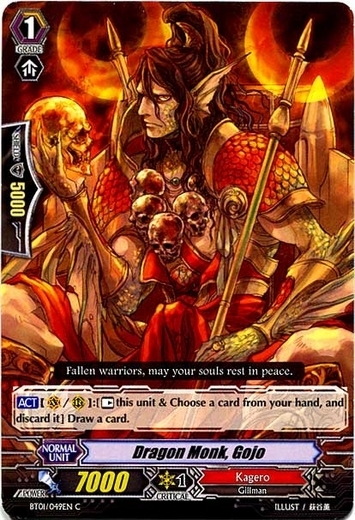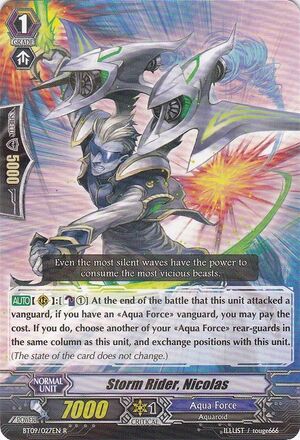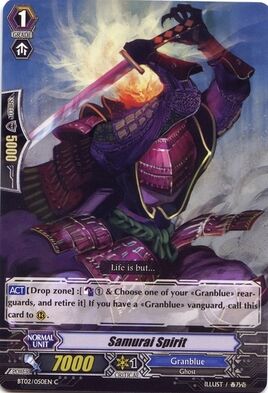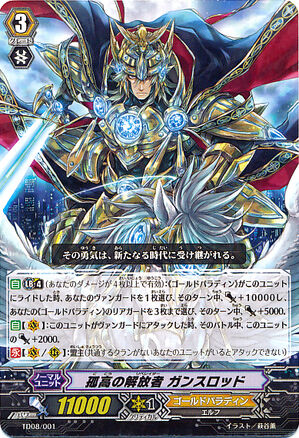Okay, so I think we all have the general gist of how the output of skills and Counter-Blasts work. If you want to use a skill, most likely you're going to have to meet some sort of requirements to activate its skill. Between outside restrictions to outright costs, the general idea would be that the better the skill, the higher the requirements needed to activate it. In fact actually, there is a very real pattern to how many Counter-Blasts you use to how profitable a skill is.
Amount of Low Quality Advantage Generated:(X)=Amount of Counter-Blasts:(X)
Amount of High Quality Advantage Generated:(X)=Amount of Counter-Blasts:(X+1)
Amount of Counter-Blasts:(X)=Amount of Soul-Blasts:(2X)
Worth X Soul=Reduce Base Power by X000
10K Vanguard=2 skills, 11K Vanguard=1 Skill+Restriction
Worth X Soul=Reduce Base Power by X000
10K Vanguard=2 skills, 11K Vanguard=1 Skill+Restriction
An interesting fact about a resource based game is that the key to making every card balanced with each other is literally placed within the cost management of resources. It should be no surprise that X cost=X output, and from there, you can build and grow. The biggest rule to maintaining balance in a resource based game is that all cards must abide by the same set of rules, and those rules must be cohesive enough that they work together without giving any notable advantage to one set of cards that follows one rule than another. By basing all cards off the same set of clearly labeled rules, a more balanced game can be born.
Each rule I have above has very real examples already existing in the game:
   |
From left to right, you'll notice that Gojo's skill is a break even, a +0. Nicolas can facilitate another attack, usually a +1. Finally Ezel can call out a random unit and gain large amounts of power, a +2. Interestingly, also from left to right, these cards are costed with 0, 1, and 2 Counter-Blasts, respectively. Another important thing to note is that all these skills are of relatively poor quality. Whether in a literal sense like Ezel's random topcall, to slightly more complicated reasoning like behind Nicolas, this lays the groundwork for the first rule of these erratas.
Amount of Low Quality Advantage Generated:(X)=Amount of Counter-Blasts:(X)
So with this first rule in set, we have the basic groundwork for low quality advantage generated. But what about higher quality advantage?



Where Conroe retires itself in trade to grab another copy to create a break even in raw advantage, there is a very clear cut and notable auxiliary advantage in virtually directly upgrading it into a better suited Grade 1. Akane meanwhile, who generates only a +1 in card advantage, however being able to choose any High Beast Royal Paladin to start developing the field, get power plays off of through Toypugal, and combo plays off Toypugal and eventual Soul Saver Dragon. Vermillion wraps up this trio of examples with its ability to devastate the frontrow. Under the context of being a late game skill so that forcing the opponent to at least guard the Vanguard is a given constant, Vermillion's ability to take down at the very least 2 more cards (assuming you aren't some nut who will send your Rear-Guards to attack theirs beforehand) makes it a solid +2. From there, the gigantic scare tactic of the very obvious destruction of power lines, and actually destroying power lines, is a clear representation of the extra auxiliary advantage of the skill. Because some forms of auxiliary advantage can't be described by just numbers alone, it would be hard-ish to really define a 'high-quality' skill, however some forms of card advantage are clearly better than other, and should be noted. From consistency issues to generating real numerical side advantage to threats and imposing this auxiliary advantage, high quality skills all seem to have an extra Counter-Blast cost on top of the [X +'s=X CBs] earlier established. Conroe's break even upgrade leads to 1 Counter-Blast, Akane's specified +1 costs 2 Counter-Blasts, and Vermillion's destruction imposing +2 is worth 3. These patterns lead to:
Amount of High Quality Advantage Generated:(X)=Amount of Counter-Blasts:(X+1)




Deadly Nightmare and Samurai Spirit are almost complete clones of each other, with the exception that Nightmare uses Soul-Blasts compared to Samurai's Counter-Blast. 2 of them in fact, double the number of Samurai Spirit's single Counter-Blast. This is also seen in Iwanagahime's skill using 6 Soul-Blasts, compared to Vermillion's comparably similar 3 Counter-Blast skill. And so the third law:
Amount of Counter-Blasts:(X)=Amount of Soul-Blasts:(2X)
You'd have to start with how much the skill is worth as Counter-Blasts, then translate it to Soul-Blasts, though.



For skills that can't be constantly maintained, or their initial use almost immediately calls for it, some units can't really demand Counter-Blasts - at least not in a regular fashion. Using the arguments that being a high quality skill is worth an extra Counter-Blast, and that 1 Counter-Blast is worth 2 Soul-Blasts, one can view 1 Counter-Blast can act as a qualitative half step. Interestingly, Kimnara plays as evidence as one of the easiest ways to determine the base power of Rear-Guard based units. Where its ability to kill off another, possibly far better, Rear-Guard is almost very clearly worth 1 Counter-Blast after you consider you also lose Kimnara, it's also only a 6K unit. You should remember that in the same set Kimnara was introduced, Blazing Flare Dragon had also just entered the scene, meaning that Kagero did have ways to use Soul - Soul that Kimnara Soul-Charged itself for. Along with its very clear ability to make a high quality break even for 1 Counter-Blast, the extra Soul-Charge also made it different than Grade 1 7K units, as its base power was now 1K less than them. This step can be followed through to 6K Pseudo 9K boosters like Toypugal, who on top of the requirements met also would have 1K power reduced from its base power for a qualitative half-step, or the especial intercepts, who although can be viewed as a really good break even, has far too many ways to fail to really warrant a full qualitative Counter-Blast, and would seem more worth like a single Soul-Blast, or rather, have 1K less base power.
Worth X Soul=Reduce Base Power by X000
The final proof is simply so wide spread that I don't especially feel the need to bring in examples.
Among cards that are very obviously meant to be Vanguards, there's generally a distinct distribution of skills among the Grade 3s. Vanguards with only 1 skill tend to have 11K bodies, while Vanguards with 2 tend to be 10K body. Ignoring very clearly mechanically broken cards, like Cross-Rides and current Break Rides, a huge majority of cards tend to follow this general guideline. Extensions to this rule is that 11Ks generally have a drawback of some kind, whether it's losing power in the presence of another clan, the lack of another unit of the same clan, or flat out losing its attack capabilities, or even other cases like Dangarii, a large majority of 11Ks abide by this restriction. While not as abundantly, a 10K Vanguard's secondary skill is an immediate trade for its 11K status. Where 11Ks have defense against more simplified 10K, 15K, and 20K columns, a 10K Vanguard's secondary skill would often be a means of increasing its overall attack power, like gaining +3K power as it attacks. It should be noted that cards like Alfred and Dangarii who have extra 'skills' to act as collaterals for a more evident and actual skills should stay as an exception, still treated as though they have 2 and 1 skills respectively. This difference in base power between Vanguard type Grade 3s and Rear-Guard type Grade 3s is distinct, and should be treated differently unless an extreme exception to the rule is present.
10K Vanguard=2 skills, 11K Vanguard=1 Skill+Restriction
Examples of Errata

11,000/Grade 3
[AUTO] Limit Break 4 (This ability is active if you have four or more damage):When a «Gold Paladin» rides this unit, choose one of your vanguards, and that unit gets [Power]+10000 until end of turn, and choose up to three of your «Gold Paladin» rear-guards, and those units get [Power]+5000 until end of turn.
[AUTO](VC):When this unit attacks a vanguard, this unit gets [Power]+2000 until end of that battle.
[CONT](VC/RC): Lord (If you have a unit that doesn't belong to the same clan as this unit, this unit cannot attack)
[AUTO](VC):When this unit attacks a vanguard, this unit gets [Power]+2000 until end of that battle.
[CONT](VC/RC): Lord (If you have a unit that doesn't belong to the same clan as this unit, this unit cannot attack)
Along with this, Gancelot faces having 2 skills despite its 11K status, which breaks the standard set by the 5th rule. Because Royal Paladins have had a decent track record with almost nothing but 10K Vanguards, the simple approach is to remove its 11K status for a 10K one, make it still be a 13K attacker, and remove Lord. Post errata, Gancelot should look like:

10,000/Grade 3
[AUTO] Limit Break 4 (This ability is active if you have four or more damage):[Counter-Blast (3)] When a «Gold Paladin» rides this unit, you may pay the cost. Choose one of your vanguards, and that unit gets [Power]+10000 until end of turn, and choose up to three of your «Gold Paladin» rear-guards, and those units get [Power]+5000 until end of turn.
[AUTO](VC):When this unit attacks a vanguard, this unit gets [Power]+3000 until end of that battle.
[AUTO](VC):When this unit attacks a vanguard, this unit gets [Power]+3000 until end of that battle.

11000/Grade 3
[CONT](VC/RC):If you do not have another «Kagero» vanguard or rear-guard, this unit gets [Power]-2000.
[ACT](VC/RC):[Counter Blast (3)] Until end of turn, this unit gets [Power]+5000, gets "[AUTO](VC/RC):When this unit's attack hits an opponent's rear-guard, [Stand] this unit", and loses "Twin Drive!!".
[ACT](VC/RC):[Counter Blast (3)] Until end of turn, this unit gets [Power]+5000, gets "[AUTO](VC/RC):When this unit's attack hits an opponent's rear-guard, [Stand] this unit", and loses "Twin Drive!!".
Dragonic Overlord actually lowers the overall B.a.s.s. value if you were to use the skill as a Vanguard, so I guess not basing off that, but instead its Rear-Guard skill. Now as a Rear-Guard, automatically assuming it gets blocked under the prospect that it's an on-hit skill, instead of losing card advantage to the loss of Twin Drive, you only gain that power boost, and force out an extra card. While this +1 is arguably so good to be worth an extra half step, the skill's inviability as a Vanguard should be noted otherwise, making the card more worth only 2 Counter-Blasts.
[ACT](VC/RC):[Counter Blast (2)] Until end of turn, this unit gets [Power]+5000, gets "[AUTO](VC/RC):When this unit's attack hits an opponent's rear-guard, [Stand] this unit", and loses "Twin Drive!!".

5000/Grade 1
[AUTO]:[Soul Blast (2)] When this unit is placed on (RC), if you have a «Oracle Think Tank» vanguard, you may pay the cost. If you do, draw a card.
I'd also like to keep the 5K power for authenticity purposes, so using the 4th skill, we can scale down the 3 Soul costing skill into only 1. This would mean that, at 5K power, Luck Bird deserves to only be worth 1 Soul-Blast.
[AUTO]:[Soul Blast (1)] When this unit is placed on (RC), if you have a «Oracle Think Tank» vanguard, you may pay the cost. If you do, draw a card.
Are you saying break ride is broken?
ReplyDeleteDefine broken.
DeleteNo seriously, what definition are you talking about. We can be talking about extremely overpowered cards that far overshoot a game's boundaries, or we can be talking about mechanically broken cards that invalidate core principles of the game. If the former, yes. The latter, no.
I'm a bit confused here, with luck bird you arrived at it only needed to cost 1 soul blast to make it fair.
ReplyDeleteWorking backward on your logic. You said a 7k power luck bird with a skill that cost 3 soul blast is fair.
Working backwards and extrapolating on "Worth X Soul=Reduce Base Power by X000" implies that you think 8k power luck bird with a cost of 4 soul blast skill is fair.
Backwards yet once again implies that you think 9K power luck bird with the skill costing 5 soul blast is fair.
9K power luck bird is obviously not fair
I don't think i get "Worth X Soul=Reduce Base Power by X000" very well please elaborate
Well that's because you're not using it correctly...
DeleteTell me, what does REDUCE mean again? REDUCE, you know, not adding on, REDUCING.
Okay I'll stop doing that, but seriously, don't do what you just did please.
This comment has been removed by the author.
DeleteI'm not trying to be awkward or anything, but i really don't think "Worth X Soul=Reduce Base Power by X000" applies.
DeleteBack to the example of luck bird. It's reduced by 3000 from 8000 (base vanilla grade 1) so it's ability is worth 3 souls on top, correct? Now let's consider what luck bird does exactly it draws a card for soul blast 2. So this implies that the price of a random card from the deck is 5 souls.
That seems ridiculously steep considering a random card can at best be considered as Low Quality Advantage worth 1 counterblast or 2 souls. It's not as if you're searching for what you want as in the case of conroe or akane. And yet you're paying as much if not more for the privilege of having a 5k booster which you'll have to replace eventually to hit proper stages.
That doesn't seem right and it suggests to me somewhere, something went wrong.
Instead I think Luck Bird should be priced as either:
7k grade 1 requiring 2 soul blast to draw a card
6k grade 1 requiring 1 soul blast to draw a card
5K grade 1 requiring no soul blast to draw a card
That way Luck bird might see some play. As it is even after your errata, i don't think luck bird will see any play.
It was more of a comment for "Backwards yet once again implies that you think 9K power luck bird with the skill costing 5 soul blast is fair." which is a retarded statement when I am specifically only saying to reduce, not 'work backwards' and add on.
Delete" It's reduced by 3000 from 8000"
Oh, wait no. I start from 7K and 9K for Grade 1s and 2s respectively as skilled units. Along with this, I specifically set it to 3 Soul because there's virtually no other condition to its skill which would be crazy to let loose too easily even if Draws can be argued as low quality advantage. I mean, I even said so in Luck Bird's explanation, virtually conditionless skill .-.
...And to be frank, Luck Bird may be a cloned unit but it certainly isn't splashable in many builds and in no way was that specific errata supposed to incite more play, just simply add as a buff to the decks that do utilize it despite its currently steeper cost.